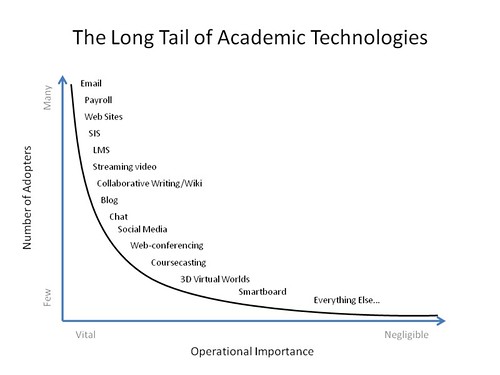But something has started to bug me a while ago. It seems to me that as time goes by and that we become more engaged with web 2.0 technologies in our everyday lives, more and more workers are shifting their attention away from centrally supported IT systems to really take advantage of free web services. And who can blame them, I do exactly the same thing myself:
- I use Evernote for all my meetings and to dos.
- I use Dropbox to keep current files at hand.
- I use Diigo and Delicious for my bookmarks.
- I publish blog posts here, in addition to my professional blog that I just started a couple of months ago.
- I publish pics on Flickr and videos on Youtube.
- And many more...
There is most certainly some good and some bad in this, as described by Michael Zimmer and Bruce Maas in their Educause Live Webinar called "What Do Newer Generation Faculty Want from IT Services?" But good or bad, the shift is happening, and how central IT units will react will determine if workers will continue to see us as problem solvers instead of red tape addicts.
My Understanding of What's Happening
I think that the Long Tail model, as made popular by Chris Anderson, is a good way to visualize my take on this. First, here's a very loose representation of what I believe are the most commonly encountered technologies in higher education institutions.

Now, traditionally, central IT has supported the most commonly used technologies, which is the right thing to do.

As more technologies become available, and as computing power and bandwidth become better and cheaper thanks to Moore's Law, some very common technologies are becoming very common.

Under the new digital economy, some vital services have become commodities, i.e. they can be outsourced for a fraction of the cost of supporting them internally. It's happening right now with email (e.i., Microsoft Live, Google Apps), and there is no reason to think it's not going to happen to other technologies as well. The newly liberated central IT time can be allocated at supporting technologies that have some potential for widespread adoption further down the tail.
George Siemens, in his excellent post called "Well Played, Blackboard", explains how this company's survival is down the tail. By acquiring Elluminate and Wimba, they have gained access to a niche market that still has potential for growth, as the traditional LMS features are becoming more of a commodity.
What Does This Means?
I think that what this means is that higher education institutions will have to revisit their old ways of supporting technologies to figure out what is obsolete and find new ways to leverage internal resources. Educators are becoming more web-savvy and will drift their own way if we can't offer something that has value to support academic work and make our institutions special.
This can also be applied at a macro-level, as discussed during my session at the Sakai conference in Denver last June. The Sakai community has to focus on what adds value to the institution, and integrate with emerging technologies instead of trying to compete, because that's just an ever losing battle.

4 comments:
very good points. I think there's still a need to provide guidance for proper application of academic technologies to align for standards and learning outcomes.
Mathew - this is outstanding. I gave a very much related talk at the recent International Conference on the Learning Sciences (ICSL2010) titled "Preparing for the Long Tail of Teaching and Learning Tools". I draw nearly the exact same diagrams - but yours are nicer with more detail and better examples. Here are my slides - http://www.slideshare.net/csev/icls2010-preparing-for-the-long-tail-of-teaching-tools - I think that this is am important theme to begin to talk about. Part of the reason I have spent the last few years focusing on IMS Learning Tools Interoperability is to enable the model you propose. I think that for the long tail to work - we much aggregate learning demand across all of the LMS systems and present it to vendors like Flickr, etc. I think that we need to get to the point where Delicious gives us a "learning view" of their service.
@Lulu & al.: Yes, segmentation of the learning experience and empowerment of the end-user (in our case the student) involves that assessment of learning at the institutional level is at best problematic. For instance, E-Portfolio systems have to become so bloated because they have to keep copies of the original artifacts, as originally submitted. If that artifact is a PDf, that's fine. But if it's a Google site, or a Voicethread, or a Prezi, or a discussion on Twitter... You see where I'm getting at...
@Dr. Chuck: I have been thinking about standards for a while myself. Unfortunately, they bore me to death, so I'm glad you're working on them. Enabling a single framework would definitely make our work easier, as well as single sign-on services like InCommons and OAuth. Identity management has to be able to carry permissions from one service to the other to enable content protection to some extend.
Don't get me wrong, I'd like all content to be open (and I'm pushing for it every single day), but as long as the current economic model is in place, professors are still going to rely on textbook publishers, and their content is going to become more and more digital.
Hey, who knows, maybe someday you'll build a slide to make fun of me ;-) In the meantime, I'd be glad to trade notes at some point...
Post a Comment